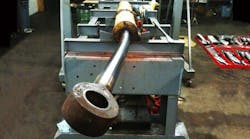4 Ways to Reduce Hydraulic Cylinder Failure and Repair Costs
As a product group, hydraulic cylinders are almost as common as pumps and motors combined. So if you operate a lot of hydraulic equipment, it’s likely that cylinder repair expense is a significant portion of your total operating costs.
According to some studies, up to 25% of mechanical equipment failures are failures of design. If we apply this to hydraulic cylinders, then as many as one in four hydraulic cylinders are not adequately designed for the application they’re operating in.
This doesn’t mean that the cylinder won’t do the job asked of it, it will - but not with an acceptable service life. So if you have any cylinders that don’t last like they should you may need to address one or more of the following four issues:
1. Bent Rods — Bending of cylinder rods can be caused by insufficient rod diameter or material strength, improper cylinder mounting arrangement or a combination of all three. Once the rod bends, deforming load is placed on the rod-seal. This increases leakage and ultimately results in premature failure of the seal.
The allowable rod loading for a cylinder in an existing application can be checked using the Euler formula. The detailed procedure for doing this is explained on pages 58 and 59 of Industrial Hydraulic Control; www.IndustrialHydraulicControl.com
2. Rod Finish — The surface finish of the cylinder rod has a significant effect on the life of the rod seal. If the surface roughness is too low (smooth), seal life can be reduced as a result of inadequate lubrication. If the surface roughness is too high, contaminant ingression is increased and an unacceptable level of leakage past the rod seal can result.
In the context of extending cylinder service life, think of the cylinder rod’s surface as a lubricated, wear-surface and treat it accordingly.
In some applications, the use of an alternative rod surface treatment with superior mechanical properties to conventional hard-chrome plating, such as nickel-chrome plating or high velocity oxygen fuel (HVOF) metal spraying, can increase the service life of the rod and its seals.
And in some cases, the installation of a shroud or bellows to protect the rod surface and its seals from impact damage and contaminants, can afford similar life extension benefits.
3. Ballooned Tubes — Ballooning of the cylinder tube is usually caused by insufficient wall thickness and/or material strength for the cylinder’s operating pressure. Once the tube balloons, the correct tolerance between the piston seal and tube wall is lost, allowing high-pressure fluid to bypass the seal. This high velocity fluid can erode the seal and localized heating caused by the pressure drop across the piston reduces seal life—the end result of which is: premature failure of the piston seal.
4. Insufficient Bearing Area — If the surface area of the bearing (wear) bands in the gland and on the piston are insufficient to adequately support the side thrust transferred to the cylinder, excessive load is placed on the rod and piston seals. This results in deformation of the seals, and ultimately, their premature failure.
Repair or Redesign?
To summarize, not all hydraulic cylinders are made equal. So if you have any hydraulic cylinders that suffer recurring failure, it’s likely that design modifications are required to break the vicious circle of failure and repair.
For more tips like this, get my FREE special report, ‘6 Costly Mistakes Most Hydraulics Users Make and How You Can Avoid Them’, at www.HydraulicSupermarket.com

